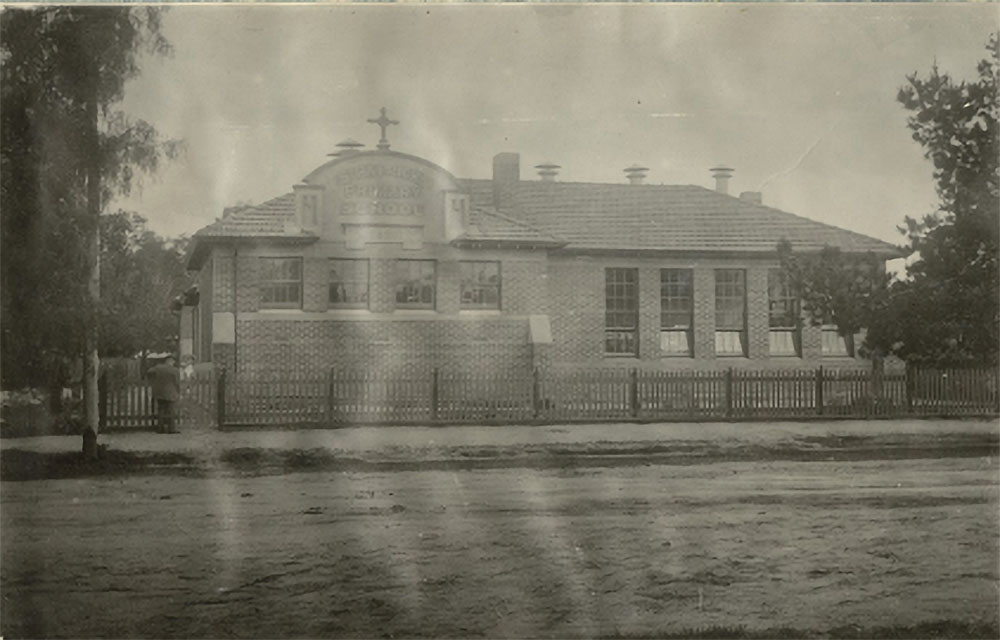History
St Patrick’s School was first established in 1854. Fr Smythe was the Parish Priest of the district. He was based in Beechworth which was a progressive community due to the discovery of gold in the area At the time, the school was run by lay teachers. Originally, it ran two schools, the first being a day school and the other a night school for students who could not attend during the day due to working on the family farm and for adults who wanted to learn to read and write.
St Patrick’s School was first registered in 1858. It was opened by Fr Kums, the Parish Priest of Beechworth who administered to the Wangaratta District at that time. Mr and Mrs Michael Toohey were the day teachers.
In 1862, Wangaratta was declared a separate Mission and the Parish of Wangaratta was established. Fr Devitt Galen was the first Parish Priest.
During this time, the school was a small wooden building that was located beside St Patrick’s Church in Ford Street.
In 1877, Government Aid was withdrawn from denominational schools and, despite this, St Patrick’s Primary School struggled on for the next ten years through the dedication and charity of the parishioners of Wangaratta.
In 1887, Reverend Dr Crane (the first Bishop of Sandhurst) sent a request to the Reverend Dr Lynch (Bishop of Kildare – Ireland) for Brigidine Sisters to be sent from Goresbridge, Ireland, to take control of St Patrick’s School. The Brigidine Sisters arrived in 1888 and assumed the running of St Patrick’s Primary school as well as establishing a finishing school for girls (St Joseph’s College – later to become part of Galen College).
The Brigidine sisters impact on Catholic Education has been enormous. Their charism of strength and kindness is reflected within the culture of St Patrick’s Primary School and it is the centrepiece of their association with the Parishes of Wangaratta for well over one hundred and fifty years.
In 1921, a new school was established on the current Ovens St site as Catholic Education continued grow. The new school was officially opened by Archbishop Mannix.

Archbishop Mannix parading through the streets of Wangaratta as part of the opening of St Patrick’s School (1921).

St Patricks School opened on the new site 31 October, 1921
By the 1950s Wangaratta Catholic Education was thriving, with St Patrick’s Primary School enrolments exceeding 425 students. This resulted in the expansion of Catholic Education Wangaratta, through the building of Our Lady’s Primary School, in 1958, and St Bernard’s Primary School in 1963.
In 1998, Mr Terry Corrigan became the first lay Principal of St Patrick’s since the Brigidine Sisters took over the running of St Patrick’s Primary School in1888. In this time school has redeveloped the original buildings through several capital grants and seen the enrolment grow from 125 to 300 students.
Vision
St Patrick’s Primary School strives to:
School Philosophy
Our motto Living, Loving, and Learning in Christ, underpins all we strive to achieve within our school community. We lay the foundation for the future by providing our students with many opportunities in which to learn, grow and succeed.
St Patrick’s was founded on the charism of the Brigidine Order of strength and kindliness, goodwill and commitment. This charism is enacted today through our teaching and care for our students.
The holistic development of each student, spiritual, academic, social and emotional is paramount to each individual’s growth and development.
Within all practices and engagements amongst students, teachers and the community, including teaching and learning programs and school organisational structure and initiatives, the vision of the school will sit at the centre.
Evaluation is vital to the growth and betterment of all. Evaluation process informs performance in all areas of school life, including the implementation of the vision and values of the school.
Our philosophy guides our teaching, strategic plans and governance decisions.
To ensure that current and prospective staff, students and parents understand the philosophy of our school St Patrick’s, we publish this philosophy in our: Policies and Handbooks.
Graduate Outcomes
We endeavour to create graduates who will:
Australian Demographic Principles
Australian society is defined, among other aspects, by a belief in elected Government; by a commitment to the rule of law, to equal rights for all before the law; and by a belief in freedom of religion, freedom of speech, and freedom of association. Our society is also tolerant of a range of religious, political, social and cultural beliefs and values in the context of the fundamental principle of our democracy.
The Education and Reform Act 2006 requires all education providers to operate in a manner consistent with this set of Australian democratic principles.
In accordance with the Act, St Patrick’s Primary School delivers curriculum programs and learning and teaching in a manner that supports and promotes the principles and practice of Australian democracy.
This includes a commitment to:
- Elected government
- The rule of law
- Equal rights for all before the law
- Freedom of religion
- Freedom of speech and association
- The values of openness and tolerance






